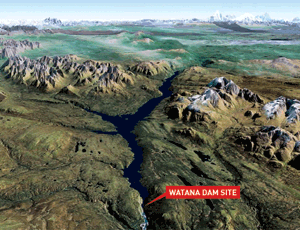After 50-plus years in the making, the Alaska state Legislature recently gave the Alaska Energy Authority approval to build and own a new dam on the Sustina River in the Watana area. The 600-MW hydroelectric dam will be the first of its kind built in the United States in more than two decades.

Preliminary work on the $4.5-billion Sustina Hydroelectric Power Project, located in Alaska’s rail-belt region about 90 miles south of Fairbanks, puts the project on track for completion in seven years and to provide new energy online by 2025. This plan dovetails with the energy goal of Alaska Gov. Sean Parnell (R): to generate half the state’s power from renewable and alternative sources by the same year.
Bryan Carey, AEA’s technical engineer and project manager, and Colorado-based engineering firm Montgomery Watson Harza now must sift through plans originally crafted in 1980 to determine their viability. The AEA also must wait for an additional $65 million from the Legislature—part of a larger special- session budget debate—to help fund design, permitting and environmental work. Carey will file a preliminary permit application with the Federal Energy Regulatory Commission (FERC) within months.
“We need to find what the first steps are to determining new study plans,” Carey says. “We are proceeding with engineering studies, looking at operational flows and height-of-dam [requirements] and determining the best powerplant size configuration.”
Plans call for a 2,700-ft-long dam at a height of roughly 700 ft from the bedrock to the top. With a proposed four turbines, AEA expects to generate 2,600 gigawatt hours per year. Parnell says the project would provide half of south-central Alaska’s electricity demand.
The state’s Bureau of Reclamation first studied the Sustina River’s hydroelectric potential in the 1950s, with another review conducted in the 1970s. In 1980, the Alaska Power Authority—now the AEA—rekindled analysis. The group applied for a FERC license in 1983 and amended it in 1985, but an estimated cost of $5.9 billion stalled the project. The state Legislature revived it in 2008, and Parnell added his support.
Geotechnical reports filed three decades ago gave Watana priority over four other potential sites. “While we still have to determine what’s valid, it gives us a major head start,” Carey says. “We already know a lot about the geology, with more than 100 bore holes already drilled.”
AEA also has in hand several major past studies about salmon and other wildlife. “We will have all that information to fall back on right now,” Carey says.
Watana was deemed superior because it could accommodate a water reservoir 39 miles long and two miles wide in an area void of man-made structures, imposed a limited impact on the salmon population and promised a continual flow of water, even in the winter. “Utilities up here [must] have energy during the winter, our peak load time,” Carey says.
Dealing with a fairly remote location with permafrost conditions and temperatures of 50 below zero will be challenging on the year-round construction schedule. Furthermore, with winter water flows of just 2,000 cubic ft per second ballooning to as much as 50,000 cfs in the late summer, putting diversion dams in place quickly could prove tricky.
Project costs have actually dropped since 1980 because of new dam-building technologies. For example, by using roller-compacted concrete construction, Carey hopes to drop the estimated project price even further. However, AEA must first be convinced the RCC technique will work on the site.
The Alaska Center for the Environment says committing such a large pot of money to a single project shortchanges alternatives that ought to be considered “in order to make the best decisions for Alaska’s energy future.” The group prefers a varied renewable-energy portfolio.
A state report suggests that, with no construction funding set aside, Alaska may shell out half the cost and use bonds to cover the remainder, with utilities helping pay down the debt as part of power purchase agreements.



Post a comment to this article
Report Abusive Comment